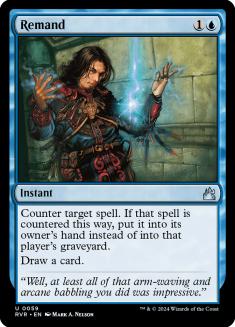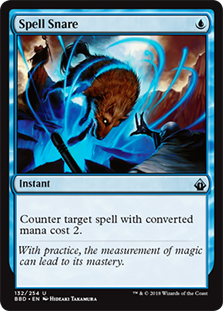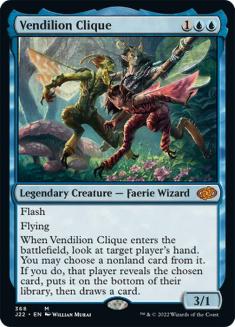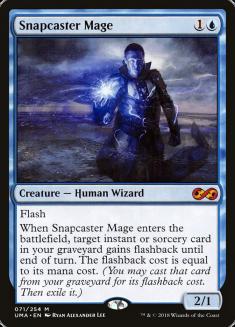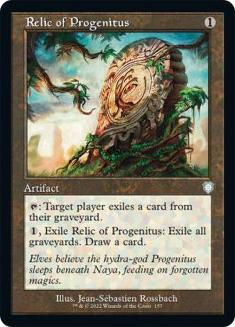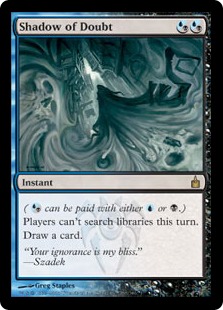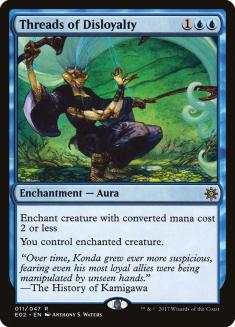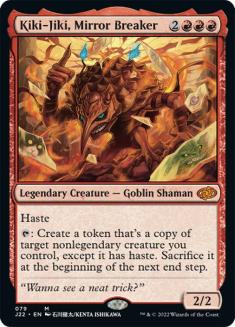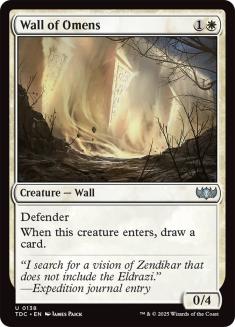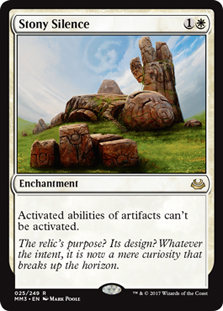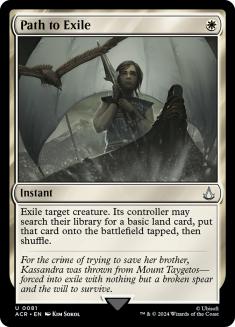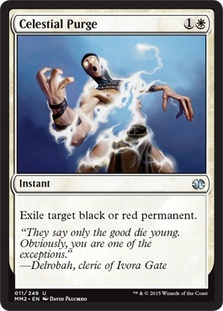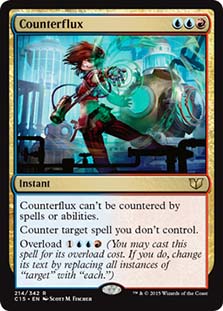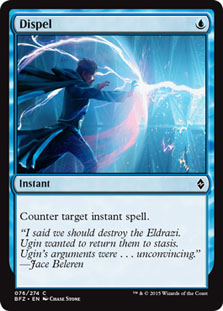Modern PTQ season is here.
I consider a Modern to be one of the most skill-testing constructed formats, which makes now a great time for a dedicated player to make it to the Pro
Tour.
Before winning the Modern Pro Tour, it was actually the format I’d had the least success in. I switched from deck to deck trying to find the right one for
me. Twin, UW Tron, Reanimator Gifts, Affinity–I’d even picked up GR Tron and played a PTQ just days after it first appeared online. I was the only one
playing it in the whole tournament and the place was crawling with Jund, but I got matched up against a maindeck Molten Rain Delver deck the first round
and was quickly eliminated.
Things started to change when I picked up UWR Control.
The format was finally slow enough for the deck to thrive and I spent time learning it inside out. That was the key. Soon I was able to see the code the
Modern Matrix was running on. I was able to follow the subtly shifting currents of the metagame. Some might say that I became one with the heart of the
cards.
I’m here today to humbly recommend Kiki Control, the deck I recently took to the Semi-Finals of GP Minneapolis. I’ll
give you the updated list, some tips for playing and sideboarding, and how you can adapt it for the metagame you expect to face.
Here is the shell I recommend:
Creatures (14)
Lands (26)
Spells (20)

Overview
*Wolf Whistle*
A thing of beauty, innit? I want to be playing those cards.
This list is a tighter package, better able to attack a more crystallized format. It moves away from the “bolt everything that moves” strategy of classic
UWR by focusing more on the creatures. The basic game plan is disrupt whatever you’re opponents doing using removal and counters until you can start
jamming Restoration Angels for value and Kiki-Jikis for more value (or the win).
4 Path to Exile and only 3 Lightning Bolt is mainly for Jund decks and other Restoration Angel decks. Right now Modern is trending towards Jund being very
good, aka “Junding.” The theory behind a Junding format is that, given enough time in a format without any changes to the card pool, Jund will become more
and more viable until it is the only deck choice. Before you know it, you’ve traded your Celestial Colonnades for Raging Ravines, and you’ve seen
Thoughtseize cast so often you have custom lifepads that start each player on 18 life. Fight the good fight as long as you can.
Strengths
It’s easier to play and has a clearer game plan than classic UWR Control. It’s capable of winning through the combo against decks like Scapeshift, Living
End, or Bogles, where your removal isn’t effective and they would otherwise have inevitability.
It’s rare you’ll lose to screw or flood. The deck functions smooth during the early game, mulligans well, and has excellent flow thanks to all the
cantrips. The late game is covered thanks to Celestial Colonnade, Sphinx’s Revelation, Snapcaster Mage and Desolate Lighthouse, so it’s rare you ever flood
out completely if you haven’t already won with Kiki-Jiki.
The deck has a strong sideboard and some of the most powerful hosers in the format. Postboard, the deck should stack up fairly well against almost every
deck in the format.
You’ll potentially face a variety of rogue decks in Modern, especially in the early rounds of a PTQ or Grand Prix. I like to think this deck stacks up well
against the random end of the Modern pool thanks to its consistency, strong answers, and being relatively off the radar.
Weaknesses
Modern is a diverse format and control style decks have traditionally struggled. Although the deck has no nightmare matchups thanks to the combo, it’s
impossible to answer everything that can be thrown at you. For example, Affinity and Storm are at different ends of the all-in spectrum, and the deck is
basically split in two with answers for both plans; removal for Affinity and counters for Storm.
The deck can be tricky to play since you will have many options and instant speed spells.
This is an interactive deck despite appearances, you’ll rarely be able to Mana Leak everything that moves or combo off without incident.
The deck can be slow. Going to time and receiving unintentional draws is a real concern. You will also get tired from playing long rounds and
you’ll probably make mistakes. The combo helps solve this problem, but not entirely.
The format will adapt if the strategy picks up steam. Right now, there isn’t much of a target on the deck, but there might be soon. It also requires
constant tweaking for the metagame.
The problem matchups have a small share of the metagame right now, but they do exist. Tron, Bogles, Storm, and Faeries are all tricky but manageable.
Still, if you expect to face these decks, another deck might be a better choice.
Tips
– There are many different times it is correct to play Restoration Angel. It is comparable to Vendillion Clique (though not as complicated.) End of
opponent’s turn, main phase when they’re tapped out, or during an opponents’ upkeep are the most common times to cast it. Blocking with Wall of Omens or
Snapcaster Mage and blinking it with Restoration Angel is a common play; blinking Colonnade in response to removal is also a good play if you have the mana
for it.
– Aside from winning the game by copying Restoration Angel, Kiki-Jiki will often copy other things. Wall of Omens is a common target. If your opponent is
tapped out, it will often be right to copy a Wall during your end step before they can cast removal on it (like Abrupt Decay.) The copied Wall will stay
alive and be able to block during your opponents turn. You can also copy or blink Walls in response to sac land fetches to dodge Abrupt Decay and other
removal. If you’re going to copy Colonnade, remember the copy comes into play tapped, so it doesn’t happen often. Also remember Kiki can’t copy Vendillion
Clique (or any other legends.) Occasionally, Kiki-Jiki will revert to his primal goblin roots and give hasty beatdowns and pressure planeswalkers.
– Don’t be afraid to wait to combo off if you’re in a strong position and a removal spell from an opponent will set you back. If you’re ahead, get more
ahead.
– Mana Leak and Remand are much better on the play so side them out more often when you are on the draw. Remand is almost always sided out before Leak.
– Against Living End, Desolate Lighthouse pitching Kiki-Jiki (or discarding it naturally) and playing or discarding Restoration Angel is a free combo win.
– Remanding your own spell in response to an opponents’ counter is a common play and a nice one-for-none. You should actively be looking to do this against
other decks with counterspells.
– Relic of Progenitus is an excellent card right now. You still bring it in against a boatload of decks. It’s good against Tarmogoyf, Scavenging Ooze,
Knight of the Reliquary, Snapcaster Mage, all the graveyard value and persist cards in Pod, Storm, Living End, and Dredge. Relic of Progentius doesn’t play
nice with your Snapcaster Mages or Stony Silences so try not to have too many copies of each in postboard and plan ahead to avoid them clashing.
VS Pod Decks
Don’t let Pod resolve. If it does, you can still try to kill and counter everything they do for a time, but eventually, Pod will win them the game if you
don’t combo off in time. Watch out for Chord of Calling; usually, you’re in the clear if they can only Chord for 3 in response to you trying to combo off.
Chord for 4 can get them Redcap or Linvala to disrupt you. Against Kiki Pod, they can Chord for Zealous Conscripts, steal Kiki-Jiki and combo off in your
end step and kill you.
Revillark is the main value creature you need to worry about, which is what makes Relic of Progenitus good postboard. It’s difficult to out-value them if
Revillark resolves, especially if Pod is also active.
Out (on the play):
In (on the play):
On the draw, I will also usually add a Stony Silence for a Mana Leak.
VS Affinity
Game 1, pray they mulligan. They are usually too fast to combo kill. Postboard, most Affinity decks go big with Etched Champion, Master of Etherium, and
Blood Moon while trying to disrupt you with Thoughtseize or possibly some counters like Spell Pierce. Mana Leak is actually decent against them postboard
since it’s capable of sniping their important spells. Stony Silence or Wrath are usually good enough to close things out, but don’t mulligan good hands
trying to find them. The deck is perfectly capable of dealing with everything Affinity throws at you naturally with just a bunch of Lightning Bolts and
Electrolyzes.
Cranial Plating and double black mana can sometimes slip through for the win so watch out for it. Try to hold onto Tectonic Edges until they play their
fourth land (or search for it from a Path to Exile.)
Out:
In:
VS Splinter Twin
You’ll often walk the tightrope of risking death from their combo and playing too safe, allowing them to have favourable trades and pull ahead through card
advantage. Game 1, it’s generally better to play safe and cast Path to Exile more aggressively if there’s a risk that they can untap and kill you with Twin
and a backup spell. You should be at an advantage in the long game thanks to Restoration Angel, and you’re better equipped to make land drops.
Postboard, they usually trim the combo and play a more beatdown tempo style. I prefer to play a more risky style and try to get in favourable spots to
extract value and let them chip away at my life total until the end game before I start Pathing their creatures. Watch out for Blood Moon and fetch plenty
of basics. Blood Moon isn’t that bad if you have your two Islands and Plains and really only disrupts Colonnade at that point.
Out:
In:
VS Jund
Liliana of the Veil is their key card against you since it takes a lot of cards and energy to get rid of it if you don’t catch it on the way down or have a
ready Colonnade.
Thrun, the Last Troll you can actually race by blinking Walls after blocking, by comboing off, or by smacking face with Colonnade. It does present a nearly
unstoppable threat that will get you eventually though and isn’t a card you want to see on the other side of the table.
Kill the Dark Confidant. Path it if you have to. You are trying to out value Jund first and foremost and that isn’t going to happen if they’re drawing two
cards a turn.
Out (on the play):
In (on the play):
On the draw, I will also usually add a Spell Snare for a Mana Leak.
Vs Scapeshift
A deck that appears to be on the rise. Time will tell if Jund’s stock inflating will keep it in check.
Right now, based on Jun Young Park’s list, the matchup doesn’t feel good. Everything in their deck interacts favourably against you, and you have a bunch
of useless Paths and Bolts. They can disrupt your combo easily and you have a very hard time stopping theirs. Many of the changes I made to the decks
sideboard were to shore up the Scapeshift match. A few Path to Exiles stay in postboard to ramp off Walls and kill Obstinate Baloths.
Out:
In:
VS UWR Control/The Mirror
I’m not telling you how to beat me.
.
.
.
Alright, fine.
Making land drops and gaining small advantages is the key. Wall of Omens really shines over something like Lightning Helix. You can afford to let your drop
into the single digits rather than counter burn if you’re careful not to die to Colonnade attacks or a sudden volley of burn when you’re tapped out. Try
and find opportunities to slip Restoration Angel into play and win counter wars. Take things slow, play a reactive game, and wait for your opponent to slip
up.
Out:
In:
These sideboards are rough guides. It’s rare you won’t change your deck configuration from game to game based on what your opponent played. You need to
develop your intuition to a point where you are willing to follow it.
The best teacher is experience, so experiment or change cards as you see fit.
Individual Cards
Lack of Cryptic Command
Purely due to the mana base needing to support Kiki-Jiki. Counterflux does a great job filling in here and is super effective against the mirror and
Scapeshift.
Wrath of God > Supreme Verdict > Porphyry Nodes
Nodes is not a consideration at all if Wall of Omens is in the deck.
Supreme Verdict’s uncounterabilty can be useful, but I prefer being able to blast through Thrun, the Last Troll as well as corner cases like Experiment One
or Welding Jar. Expect Thrun to continue to show up a decent amount now.
Wrath is also ever so slightly easier on the mana base over Verdicto Supreme in cases where you draw multiple Tectonic Edges, multiple Islands, or the
Mountain.
It’s back! Thanks to the rise of Jund I can once again justify running Threads. O happy day!
Your Metagame
If you’re going to make changes, make sure your postboard configurations are still decent against the top decks.
Magic Online has lots of Burn, Tron, and UR Delver decks so if you’re playing there, you might want Timely Reinforcements or Sowing Salts in the board.
Grand Prix have lots of Affinity. It’s easy to shave a Stony Silence if you don’t expect much Affinity since that’s really the only reason the third one is
in the board. Be careful though – if Jund remains a strong choice, so too does Affinity
If you’re trying to win a PTQ, do some research on past Modern events. Modern is a format that has some history and if you’ve been playing in your area for
a while, you might have some useful information stored. Are things more Aggressive, Controlly, or Junding? Think about what the top players in your area
will play and take that into account.
You can tune UWR a bit further towards beating aggro, say by adding Lightning Helix back in, but it’s important to keep in mind winning the tournament will
probably require you to beat skilled opponents piloting tricky decks.
Adapt or Die
The winds of change are already blowing. Keep tuning and tinkering.
Also remember that at the end of the day, the play is still the thing. More important than the 15th sideboard slot is how well you’re able to
pilot the 75 cards you have. Practice a bunch, and you will succeed.
That’s all for now. If you do pick up the deck, I hope casting Wall of Omens brings you the same joy it brings me.


